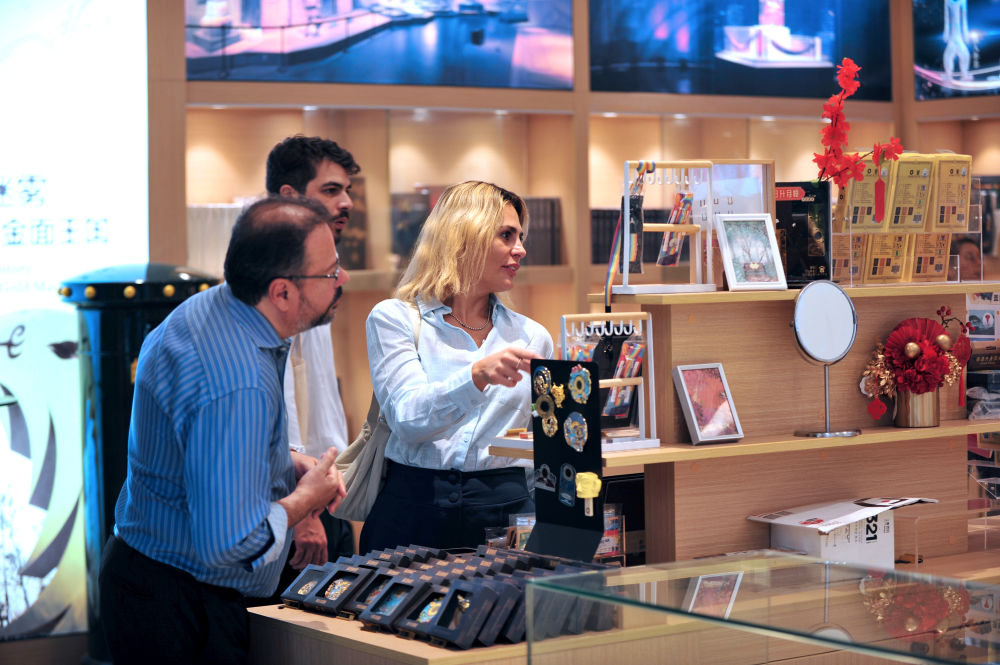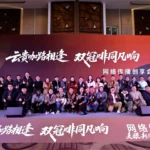Riding on the convenience of transit visa-free policies and other inbound tourism measures, Chengdu, with its unique natural beauty and vibrant cultural charm, has become a magnet for global travelers. According to Trip.com’s “2024 China Tourism Destination Heat Map,” Chengdu ranks first among the most-searched cities by foreign tourists. In the first half of this year, Chengdu’s airport recorded over 3 million inbound and outbound passengers, leading central and western China in both passenger volume and flight numbers.
The surge in inbound tourism reflects the strong “magnetic pull” of China’s efforts to facilitate travel and the boundless “gravitational force” of western China’s expanding openness. As an inland hub of international exchange, Chengdu not only exemplifies dynamic cultural and tourism development but also serves as a vibrant window into China, showcasing confidence, inclusivity, and the pulsating energy of the times.
Unique Attractions “Activate” Global Tourism
“Dice the chicken evenly, soak the dried chilies first…” At the Chengdu Cuisine Museum, a Chinese chef guides Greek influencer Sophia in making Kung Pao chicken. As Sophia tosses chilies into hot oil, the aroma instantly fills the air with flames, prompting her to exclaim, “So this is ‘mala’!”
On July 1, the Chengdu-Istanbul-Athens route was officially launched, the first direct flight from central and western China to Athens. Five Greek influencers took this flight to explore Chengdu—visiting pandas, enjoying face-changing performances, and cruising the Jinjiang River—packing their five-day itinerary with unforgettable experiences.
Chengdu, renowned as the “Hometown of Pandas” and the “Capital of Gastronomy and Leisure,” dazzles with its ancient Shu civilization, Three Kingdoms history, and poetic heritage, attracting countless international visitors each year. Some come to see the adorable giant pandas, others are captivated by the millennia-old relics of Jinsha Site and Wuhou Shrine, while many marvel at the ingenuity of the Dujiangyan Irrigation System or the trendy vibe of Dongjiao Memory. These unique cultural and tourism resources continue to draw global attention.
At the Panda Base, Vietnamese traveler A Chuan happily poses for photos with pandas, planning to visit all panda-related landmarks in Chengdu. In Kuanzhai Alley, South Korean tourist Kim Seo-yeon embarks on a “City Walk,” snapping photos, shopping, and sampling local snacks. At Shuyanfu in Dongjiao Memory, over 10,000 foreign tourists have immersed themselves in Hanfu and Chinese dining culture in the first half of this year.
“I love Pop Mart and other trendy Chinese collectibles—today I finally got my favorite set!” In the Chunxi Road-Taikoo Li shopping district, Italian tourist Stefan and his friends lug bags of purchases, fully embracing the “shop till you drop” spirit.
“Bring an empty suitcase to Chengdu!” This tip circulating on overseas social media resonates with travelers. As a top-tier consumption hub in China, Chengdu is home to over 4,000 flagship stores from global brands, offering foreign tourists a “dazzling” shopping experience. Areas like Chunxi Road and Kuanzhai Alley rank among China’s top “inbound-tourist-friendly commercial zones.”
The booming “China travel” trend has kept travel agencies swamped. “Southeast Asian tourists, especially from Thailand, are flocking to Sichuan this year—our 20 Thai-speaking guides are fully booked,” said Jing Zhihong, general manager of Chengdu Free Journey International Travel Agency. Thai guide Lin Xiang echoed this: “The surge in Thai tourists is unprecedented in my 20-year career—some agencies even ‘borrow’ guides from other regions to cope.”
As the first city in central and western China with dual international airports, Chengdu is rapidly expanding its global air network. Currently, it operates 86 international and regional direct routes. In late June alone, four new routes were launched to Phnom Penh, Bangkok, Athens, and Seychelles, weaving an “aerial Silk Road” that connects Chengdu to the world.
This transportation advantage is fueling cultural and tourism growth. In the first half of this year, Chengdu’s airport handled over 3 million inbound and outbound passengers, an 11.2% year-on-year increase, including 790,000 foreigners—a 58.5% surge—highlighting its strong international appeal.
“Eating, Staying, Traveling—Everything’
Chengdu Cuisine Museum
The Chengdu Cuisine Museum, located in Sichuan, China, is dedicated to preserving and showcasing the rich history and culture of Sichuan cuisine, known for its bold flavors and spicy dishes. The museum features exhibits on traditional cooking techniques, ancient utensils, and the evolution of Sichuan’s culinary arts over 3,000 years. Visitors can also experience live demonstrations and tastings of iconic dishes like Mapo Tofu and Kung Pao Chicken.
Jinjiang River
The Jinjiang River is a major river in Sichuan Province, China, flowing through the capital city of Chengdu. Historically, it has played a vital role in irrigation and transportation, dating back over 2,000 years to the ancient Shu Kingdom. Today, it remains an important waterway and a scenic landmark, with parks and cultural sites along its banks enhancing its cultural and recreational significance.
Jinsha Site
The Jinsha Site, discovered in 2001 in Chengdu, China, is an archaeological treasure dating back over 3,000 years to the Shang and Zhou dynasties. It reveals a thriving ancient Shu civilization, with artifacts like gold masks, jade carvings, and ivory objects. The site provides crucial insights into the cultural and religious practices of early Sichuan.
Wuhou Shrine
The Wuhou Shrine, located in Chengdu, China, is a historic temple complex dedicated to Zhuge Liang, the renowned strategist of the Shu Han kingdom during the Three Kingdoms period (220–280 CE), and Liu Bei, its founding emperor. Established in the 4th century and later expanded, the shrine honors their legacy with ancient statues, inscriptions, and serene gardens. It reflects both Chinese architectural elegance and the enduring cultural reverence for these legendary figures.
Dujiangyan Irrigation System
The Dujiangyan Irrigation System, located in China’s Sichuan Province, is an ancient hydraulic engineering marvel built around 256 BCE during the Qin Dynasty. Designed by governor Li Bing and his son, it controls flooding and irrigates farmland by diverting water from the Min River without the use of dams. Still operational today, it is a UNESCO World Heritage Site and a testament to China’s advanced early engineering.
Dongjiao Memory
“Dongjiao Memory” is a cultural and creative park located in Chengdu, China, transformed from a historic industrial area that once housed the East Suburb Memory Factory. The site preserves mid-20th-century Soviet-style architecture while repurposing it into a vibrant hub for art, fashion, and entertainment. It celebrates Chengdu’s industrial past while fostering contemporary cultural innovation.
Panda Base
The **Panda Base**, officially known as the **Chengdu Research Base of Giant Panda Breeding**, is a conservation and research facility in Chengdu, China, dedicated to protecting giant pandas. Established in 1987, it focuses on breeding, research, and public education, helping to increase the population of this endangered species. Today, it is also a popular tourist attraction where visitors can observe pandas in a habitat resembling their natural environment.
Kuanzhai Alley
Kuanzhai Alley (宽窄巷子), located in Chengdu, China, is a historic area dating back to the Qing Dynasty (17th–20th century). Originally a residential zone for Manchu soldiers, it now blends traditional Sichuan architecture with modern shops, teahouses, and restaurants. The area is divided into “Wide Alley” (Kuan Xiangzi), “Narrow Alley” (Zhai Xiangzi), and “Well Alley” (Jing Xiangzi), offering a mix of cultural heritage and vibrant urban life.
Shuyanfu
Shuyanfu, also known as Qufu, is a historic city in Shandong Province, China, renowned as the birthplace of Confucius (551–479 BCE). It is home to the Temple of Confucius, the Kong Family Mansion, and the Cemetery of Confucius, all UNESCO World Heritage Sites, reflecting its central role in Confucian culture and Chinese history for over two millennia. These sites have been preserved and revered as key centers of education, tradition, and philosophy since ancient times.
Chunxi Road-Taikoo Li shopping district
Chunxi Road-Taikoo Li in Chengdu, China, is a vibrant shopping district blending modern luxury with traditional Sichuan culture. Developed by Swire Properties, Taikoo Li opened in 2015, featuring a mix of high-end retail, dining, and entertainment within restored ancient-style buildings and historic courtyards. The area preserves the charm of old Chengdu while offering a contemporary urban lifestyle.
Chunxi Road
Chunxi Road, located in Chengdu, Sichuan Province, is one of China’s most famous and bustling commercial pedestrian streets, with a history dating back to the 1920s. Known for its vibrant mix of modern shopping centers, traditional tea houses, and local snacks, it reflects Chengdu’s blend of historical charm and contemporary urban life. The area was named after the Chunxi Pavilion, a historic landmark, and has evolved into a key cultural and economic hub in southwestern China.
Kuanzhai Alley
Kuanzhai Alley (宽窄巷子), located in Chengdu, China, is a historic area consisting of three ancient alleys—Kuan Alley, Zhai Alley, and Jing Alley—dating back to the Qing Dynasty (17th–20th century). Originally a residential area for Manchu soldiers, it has been preserved and revitalized into a vibrant cultural hub featuring traditional Sichuanese architecture, teahouses, and local cuisine. Today, it blends historical charm with modern attractions, offering visitors a glimpse into Chengdu’s rich heritage.



